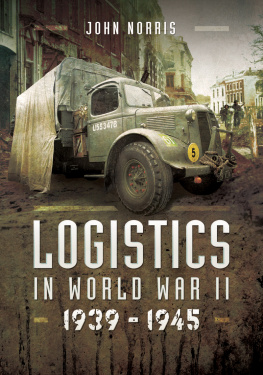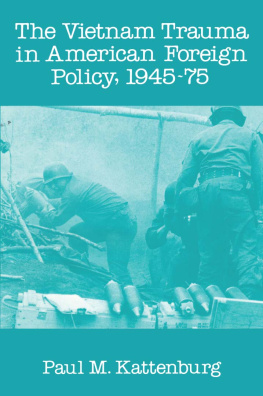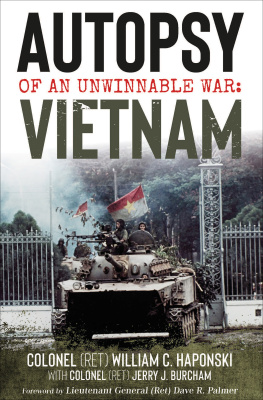A War of Logistics
FOREIGN MILITARY STUDIES
History is replete with examples of notable military campaigns and exceptional military leaders and theorists. Military professionals and students of the art and science of war cannot afford to ignore these sources of knowledge or limit their studies to the history of the U.S. armed forces. This series features original works, translations, and reprints of classics outside the American canon that promote a deeper understanding of international military theory and practice.
SERIES EDITOR: Roger Cirillo
An AUSA Book
A WAR OF
LOGISTICS
Parachutes and Porters
in Indochina,
19451954
CHARLES R. SHRADER
Due to variations in the technical specifications of different electronic
reading devices, some elements of this ebook may not appear
as they do in the print edition. Readers are encouraged
to experiment with user settings for optimum results.
Copyright 2015 by The University Press of Kentucky
Scholarly publisher for the Commonwealth, serving Bellarmine University, Berea College, Centre College of Kentucky, Eastern Kentucky University, The Filson Historical Society, Georgetown College, Kentucky Historical Society, Kentucky State University, Morehead State University, Murray State University, Northern Kentucky University, Transylvania University, University of Kentucky, University of Louisville, and Western Kentucky University.
All rights reserved.
Editorial and Sales Offices: The University Press of Kentucky
663 South Limestone Street, Lexington, Kentucky 40508-4008
www.kentuckypress.com
Cataloging-in-Publication data is available from the Library of Congress.
ISBN 978-0-8131-6575-2 (hardcover : alk. paper)
ISBN 978-0-8131-6577-6 (epub)
ISBN 978-0-8131-6576-9 (pdf)
This book is printed on acid-free paper meeting the requirements of the American National Standard for Permanence in Paper for Printed Library Materials.
Manufactured in the United States of America.
| Member of the Association of
American University Presses |
Tn cng trn troi! [Here come the air porters!]
Viet Minh exclamation on seeing
French C-47s over Dien Bien Phu
Contents
Photographs follow
Maps, Tables, and Figures
Maps
Tables
Figures
Table of Equivalencies
1 meter = 39.37 inches | 1 barrel = 42 U.S. gallons |
1 kilometer = 0.6214 miles | 1 cubic meter (m3) = 35.3 cubic feet (ft3) = 201.987 U.S. gallons = 4.81 barrels |
1 sq meter (m2) = 1.196 sq yards | 1 kilogram = 2.2046 pounds |
1 sq kilometer (km2) = 0.39 sq miles | 1 short ton = 2,000 pounds = 907.2 kilograms |
1 hectare = 2.471 acres | 1 long ton = 2,240 pounds |
1 liter = 0.2641 U.S. gallons | 1 metric ton (tonne) = 2,204.62 pounds = 0.98 long ton = 1.1 short ton |
Note on Translation, Acronyms, and Measurements
The following procedures have been adopted in this volume in an attempt to simplify the process of identifying political (territorial) entities and military organizations. Most French and Vietnamese words and terms are shown in italics. Upon first mention in each chapter, French Union and Viet Minh political entities and military organizations are identified in full by an English translation of the original French or Vietnamese designation, which follows immediately in parentheses along with the corresponding French or Vietnamese abbreviation. Thus, one finds the French General Headquarters in Indochina (tat-Major Interarmes et des Forces Terrestres, EMIFT), the 6th Colonial Parachute Battalion (6e Bataillon de Parachutistes Coloniaux, 6e BPC), Interzone V (Lien Kieu V, LK V), and the 302nd Viet Minh Division (Dai-Doan 302, DD 302). For subsequent references one or another of the three forms may be used, usually the French acronym. The most frequently used French and Vietnamese acronyms and their English equivalents are listed in the glossary, as are other terms and abbreviations. Indochinese place and proper names generally follow contemporary French usage, except that place names are given in the presumably more correct divided form. For example, one will find Na San rather than Nasan and Hoa Binh rather than Hoabinh.
In most cases, distances are given in miles, temperatures in the Fahrenheit system, and volume in gallons or barrels. However, measurements taken directly from French sources, particularly in the tables, are given in the metric system, and unless otherwise noted the word ton refers to the metric ton (tonne) of 2,204.62 pounds. For more on measurements, please see the table of equivalencies above.
Preface
Logistical considerations permeated every aspect of the First Indochina War of 19451954, dictating the selection of objectives, the organization of forces, the timing and duration of operations, and even the eventual outcome of the conflict. Accordingly, this study focuses on the organization and capabilities of both French Union and Viet Minh logistical units and on the logistical aspects of ground operations during the period of active conventional warfare in Indochina between October 1950 and May 1954. The key questions that this study seeks to answer are: How were the French and Viet Minh logistical systems organized and operated? Which of the two systems was better adapted to the existing physical and operational environment? To what degree were operational decisions based on logistical considerations? To what extent did logistical factors influence the outcome of combat operations? How effective were the logistical systems of the French Union and Viet Minh forces? The emphasis is thus on military logistics as traditionally definedthat is, on the procurement, storage, issue, and maintenance of food, clothing, weapons, vehicles, ammunition, petroleum products, and other military equipment and the distribution of such materiel by land, water, and air transport. The discussion of medical support is generally excluded, and only a limited discussion of engineer operations and of the logistical support of air and naval forces is provided. Special attention is given to transportation operations, particularly the French use of air transport and aerial resupply techniques and the Viet Minh utilization of large numbers of porters. The external logistical support provided to the French Union forces by the United States and to the Viet Minh forces by Communist China are also covered in some detail.












